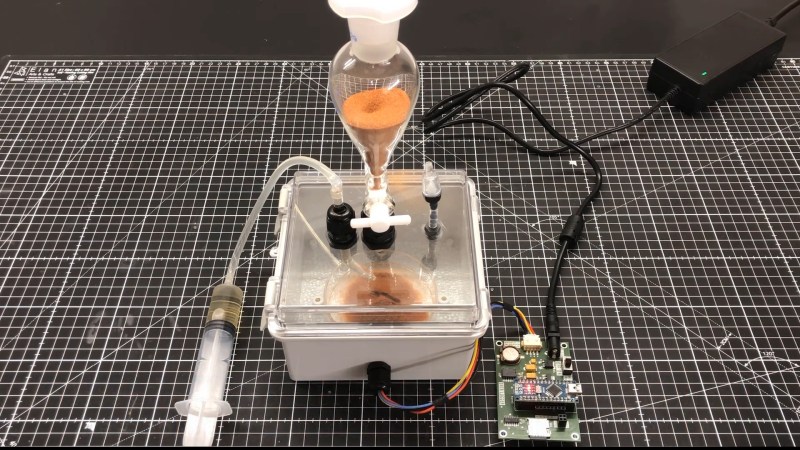With all the recent attention on Mars and the search for evidence of ancient life there, it’s easy to forget that not only has the Red Planet been under the figurative microscope since the early days of the Space Race, but we went to tremendous effort to send a pair of miniaturized biochemical laboratories there back in 1976. While the results were equivocal, it was still an amazing piece of engineering and spacefaring, one that [Marb] has recreated with this Earth-based version of the famed Viking “Labeled Release” experiment.
The Labeled Release experimental design was based on the fact that many metabolic processes result in the evolution of carbon dioxide gas, which should be detectable by inoculating a soil sample with a nutrient broth laced with radioactive carbon-14. For this homage to the LR experiment, [Marb] eschewed the radioactive tracer, instead looking for a relative increase in the much lower CO2 concentration here on Earth. The test chamber is an electrical enclosure with a gasketed lid that holds a petri dish and a simple CO2 sensor module. Glands in the lid allow an analog for Martian regolith — red terrarium sand — and a nutrient broth to be added to the petri dish. Once the chamber was sterilized, or at least sanitized, [Marb] established a baseline CO2 level with a homebrew data logger and added his sample. Adding the nutrient broth — a solution of trypsinized milk protein, yeast extract, sugar, and salt — gives the bacteria in the “regolith” all the food they need, which increases the CO2 level in the chamber.
More after the break…
[Marb]’s results are not surprising by any means, but that’s hardly the point. This is just a demonstration of the concept of the LR experiment, one that underscores the difficulties of doing biochemistry on another planet and the engineering it took to make it happen. Compared to some of the instruments rolling around Mars today, the Viking experiments seem downright primitive, and the fact that they delivered even the questionable data they did is pretty impressive.
















So did he find life?
Most likely he did. Our professor of microbiology taught us “Everything is everywhere all the time, it only depends on the conditions if it will grow”.
That terrarium sand won’t be teeming with bacteria, but it won’t be sterile either. Feed it and things will start to grow.
By the way, the graph in the video shows the logistic function: https://en.wikipedia.org/wiki/Logistic_function
Verhulst derived his logistic equation to describe the self-limiting growth of a biological population. The equation was rediscovered in 1911 by A. G. McKendrick for the growth of bacteria in broth and experimentally tested using a technique for nonlinear parameter estimation.
I was hoping for chicken broth!
The big gotcha with the Labelled Release experiment, that was not known about until many decades alter and more advanced sampling hardware made it to Mars (Phoenix, and later Curiosity), was the presence of Perchlorates in Regolith, and their interactions with the high levels of ionising radiation at the surface of Mars: https://phys.org/news/2013-11-habitable-mars-view-viking.html